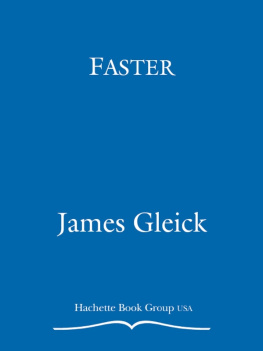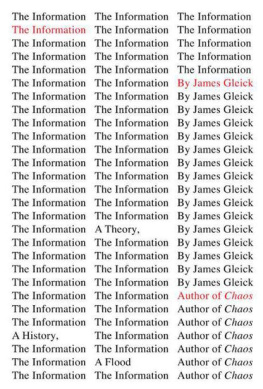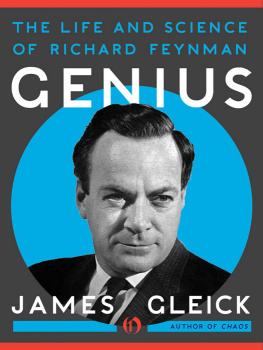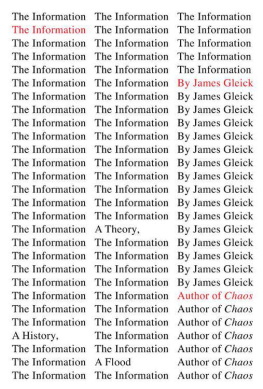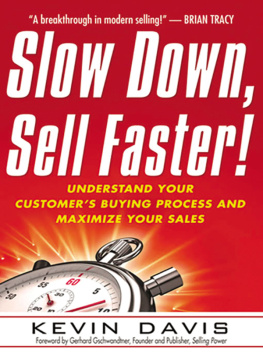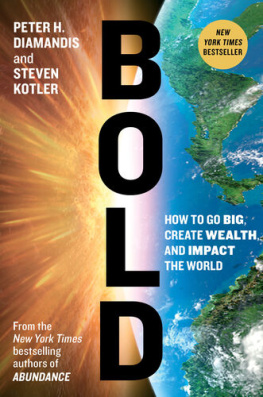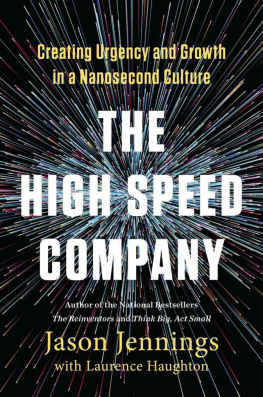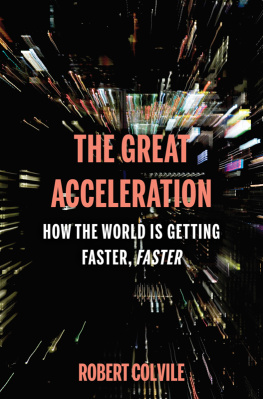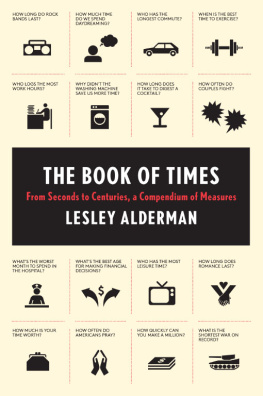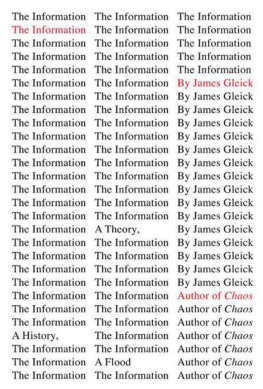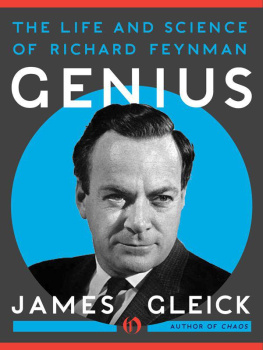Acclaim for James Gleicks
Faster
Nimble, smart, often funny, andbest of allfast.
The New York Times Book Review
Fascinating and disturbing, amusing and informative, Faster is an eclectic stew combining history, academic research, and anecdotes drawn from the popular media.
The Boston Globe
Fasters short, jewel-like essays read like dispatches from a Xanadu of maximum efficiency.
Newsday
Engaging.
Los Angeles Times
Gleick offers his pointed analysis with refreshing irreverence.
Time
Gleick has done a magnificent job of outlining and defining the problem in a cogent and witty fashion; this book is an exemplar of thorough reporting.
Chicago Sun-Times
Gleick has a great eye for todays transitions.
The Village Voice
Faster is a wry, many-faceted meditation.
Salon
Gleicks style is swift and slick, his chapters brief, and the book zips by like an Epcot monorail.
New York
Trains a magnifying glass on our speed-driven world, illuminating the modern humans obsession with time and challenging a few myths.... Thank you, James Gleick.
San Francisco Chronicle
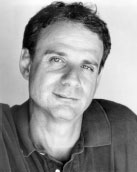
James Gleick
Faster
James Gleick (www.around.com) is the author of Genius: The Life and Science of Richard Feynman (available from Vintage Books) and Chaos: Making a New Science, both of which were National Book Award nominees. He lives in New York.
Also by James Gleick
Chaos: Making a New Science
Genius: The Life and Science of Richard Feynman
Faster
The Acceleration of Just About Everything
James Gleick
Copyright 1999, 2000 by James Gleick
All rights reserved. No part of this book may be reproduced in any form or by any electronic or mechanical means, including information storage and retrieval systems, without permission in writing from the publisher, except by a reviewer, who may quote brief passages in a review.
Grateful acknowledgment is made to the following for permission to reprint previously published material: Farrar, Straus & Giroux, Inc. and Faber and Faber Limited: Excerpt from A Girl in a Library from The Complete Poems by Randall Jarrell. Copyright 1969 and copyright renewed 1997 by Mary von S. Jarrell. Reprinted by permission of Farrar, Straus & Giroux, Inc. and Faber and Faber Limited, London. Random House, Inc. and Faber and Faber Limited: Excerpt from No Time from W. H. Auden: Collected Poems by W. H. Auden, edited by Richard Mendelson. Copyright 1941 by W. H. Auden. Rights for the British Commonwealth administered by Faber and Faber Limited, London. Reprinted by permission of Random House, Inc., and Faber and Faber Limited.
Hachette Book Group, 237 Park Avenue, New York, NY 10017
Author photograph Beverly Hall
ISBN: 978-0-446-93130-4
Originally published in the United States in hardcover in slightly different form by Pantheon Books, a division of Random House, Inc., New York, in 1999.
First eBook edition: September 2000
Visit our Web site at www.HachetteBookGroup.com.
For Harry
IN MEMORY
NOT ENOUGH TIME
Im going to kill myself. I should go to Paris and jump off the Eiffel Tower. Ill be dead. You know, in fact, if I get the Concorde, I could be dead three hours earlier, which would be perfect. Or wait a minute. Itwith the time change, I could be alive for six hours in New York but dead three hours in Paris. I could get things done, and I could also be dead.
WOODY ALLEN
Clocks cannot tell our time of day
For what event to pray,
Because we have no time, because
We have no time until
We know what time we fill,
Why time is other than time was.
W. H. AUDEN
You are in the Directorate of Time. Naturally you are running late. You hurry past a glass-paned vault in which the worlds number-one clock is soundlessly assembling each second from nine billion parts. It looks more like a rack of computers than a clock. In its core, atoms of cesium vibrate with a goose-stepping pace so sure, so authoritative, so humblingbut your mind wanders. There is not a moment to lose. Striding onward, you reach the office of the director of the Directorate of Time. He is a craggy, white-haired man called Gernot M. R. Winkler. He glances across the desk and says, We have to be fast.
The directorate, an agency of the United States military, has scattered dozens of atomic clocks across a calm, manicured hilltop near the Potomac River in Washington. Armed guards stand watch at a security gatehouse down below, mainly because the Vice Presidents residence occupies the same grounds. Once past their scrutiny you can walk alone up the long drive to the stately 150-year-old Naval Observatory, the first national observatory of the United States. Long ago a four-foot ball of Charles Goodyears Gumelastic rubber hung from a mast atop the observatory dome and dropped daily at noon to signal the time. Now the signals come more quickly. The Master Clock consults with fifty others in separate climate-controlled vaultscesium clocks and hydrogen masers powered by diesel generators and backup batteries. They check off the seconds as an ensemble and communicate continuously via fiber-optic cable with counterparts overseas. The clocks monitor one another, and individual devices can come on or off line as their performance warrants. Out-of-sync clocks reveal themselves quickly. Winkler offers an analogy: Its like a court of law, where you have many slightly different stories and one wildly different story. When the plausible witnesses are chosen and assembled, their output is statistically merged, world-wide, at the Bureau International des Poids et Mesures, outside Paris. The American contribution is the largest.
The result is the exact time. The exact timeby definition, by worldwide consensus and decree. The timekeepers at the directorate like to quote the old saw (Winkler quotes it now): A man with a watch knows what time it is. A man with two watches is never sure. Humanity is now a species with one watch, and this is it.
Through most of history, time was fixed by astronomical reference pointsthe Earth spins once, call it a day. No more. The absolute reference has shifted from the stars to the atomic beams in their vaults. Particles are steadier than planets. Never mind the uncertainty principle; it is the heavens that cannot be relied on. Stars drift. The Earth shivers ever so slightly. With the oceanic tides acting as brakes, the planet slows in its rotation by fractions of a second each year. These anomalies do matter, in a time-gripped age. To compensate, the official clocks must every so often perform a grudging two-step, adding an odd seconda leap secondto the worlds calendar. Most often, leap seconds are inserted at the close of December 31. The New Year clicks in sneakily: 11:59:58 P.M. , 11:59:59, 11:59:60 (!), 12:00:00 A.M. ,
12:00:01. The descendant of the Naval Observatorys old Gumelastic rubber ball drops, studded with light bulbs, in Times Square. Elsewhere, astronomical observatories, television networks, and time-obsessed computer users make an adjustment to catch the leap second. Observatories have been known to get the sign wrong, ruining a nights sky-watching with the difference between +1 second and 1. As the Earth continues to slow, leap seconds will grow more common. Eventually we will need one every year, and then even more. Scientists could have avoided these awkward skips by choosing instead to adjust the duration of the second itself. Who would notice? That is what they did, in fact, until 1955. They defined the second as 1/86,400 of a real day, however long that was. The second had to lengthen a tiny bit each year. The atomic clocks were retuned as necessary. This did not trouble most of us, even subliminally, but it did start to annoy atomic physicists, because they needed a temporal measuring stick that would not stretch:
Next page
